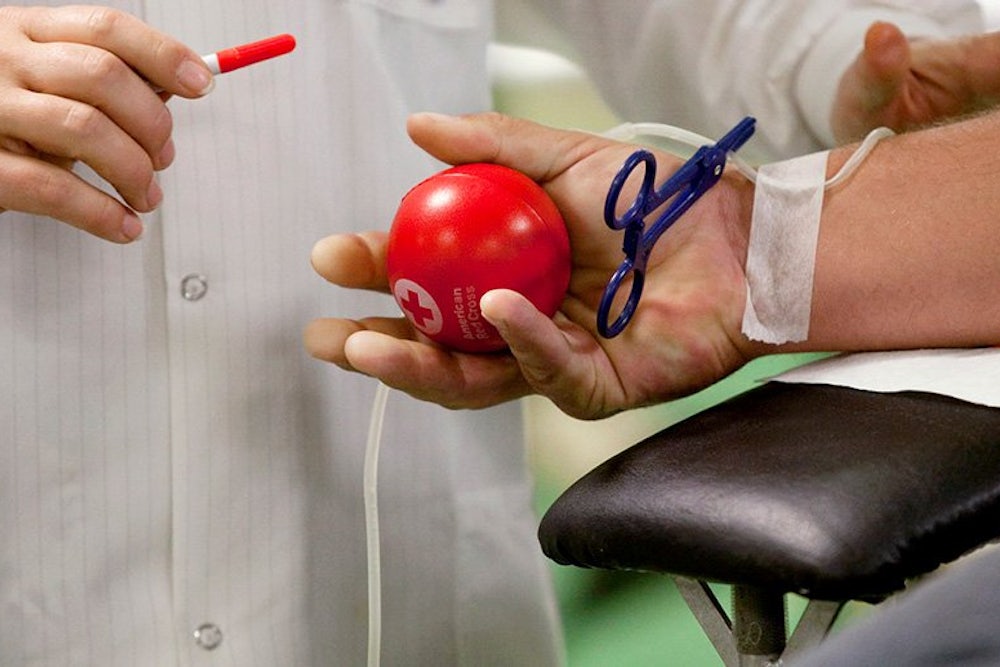Right now, men who have sex with men are forbidden from donating blood. Ever. Last week, the Food and Drug Administration released much-anticipated guidance changing the lifetime ban on blood donations from those men to a one-year ban or deferral. In other words, if a gay or bisexual man has had sex with another man in the year prior to attempting to donate, they are still prohibited from donating blood.
Going beyond the surface, though, of what is an incremental move in the right direction, one finds some unfortunate side effects. This new draft guidance is misguided in several ways: It continues to stigmatize gay and bisexual men, then does harm to the broader populace that gets the wrong public health message, and shrinks the blood supply.
First, the new policy still discriminates against gay and bisexual men. It is not hard to see how. HIV-negative lifetime partners or spouses who have had sex with no one but each other are barred from donating blood under the policy merely because they are both men who continue to have sex. For the hundreds of thousands of gay and bisexual men who have sex in any given year, the new guidance is not a change in policy at all, and in practice amounts to a lifetime ban.
More broadly, by unduly focusing on gay and bisexual men and suggesting that they are somehow uniquely at risk to HIV, the guidance sends a problematic public health message to everyone else, too. This message could contribute to America’s lack of understanding regarding how the disease is spread and what behaviors put one at higher risk. Anyone—regardless of sexuality, race, or socio-economic background—is at risk if they engage in unprotected sex with partners of unknown HIV status.
The social costs associated with this inaccurate message are just as real as the risk of transmittal through transfusion, if not more so; lack of public education and understanding regarding HIV is what causes the disease to continue to spread. The recent HIV outbreak in rural Indiana is a testament to that fact. Each year in America, approximately 50,000 individuals are newly infected with HIV, mostly through unprotected sex and injection drug use. Conversely, according to the Centers for Disease Control, the risk of contracting HIV through a blood transfusion is extremely low, and has been estimated conservatively to be around one in 1.5 million, or lower.
What’s more, the new policy bears no relationship to the length of time after exposure it takes to detect HIV in donated blood, which means it’s not rooted in science or evidence.
Under the combined antibody and nucleic acid testing regime recommended by the FDA, blood donations are subjected to extensive and accurate HIV tests. Generally, tests available for screening donations are able to determine whether the blood has HIV so long as the donor was not exposed within the last couple of weeks. For example, if a man had sex with an HIV-positive man and contracted HIV three months ago, the FDA’s recommended testing regime would in almost all instances detect the virus.
Accordingly, even assuming that gay and bisexual men are as a group more prone to HIV, notwithstanding that they might be in monogamous relationships or diligently use protection, the one-year deferral policy is not correlated to the length of time it takes for HIV to be detected within donated blood. Surprisingly, the FDA’s explanation for the new policy barely mentions the short window period during which HIV cannot be detected under the applicable tests.
Finally, by sweeping too broadly in its approach to men who have sex with men, the FDA policy also has a negative impact on the available blood supply. According to UCLA’s Williams Institute, if the ban were completely lifted, an estimated 615,300 pints of additional blood would be donated each year, compared to the additional 317,000 pints likely to be donated if the ban is changed to a one-year deferral.
There’s an easy enough fix to this. The FDA’s guidance, and the related public health message, should be targeted at individual assessment of risky behavior and lack of precautions, not a particular minority group. Such an approach would have the additional benefit of educating all prospective donors regarding the activities that might expose them to HIV, and encourage them not to engage in casual, unprotected sex with partners of unknown HIV status.
The FDA is providing a 60-day public comment period on its proposed guidance. After considering public comments, the FDA should revisit its policy and correlate any deferral period to a particularized, individual assessment of a potential donor’s risky sexual behavior (i.e., unprotected sex with partners of unknown status) and the window period during which time HIV cannot be detected under the available blood tests. By doing so, the FDA would take important steps in educating the public regarding the spread of HIV, while simultaneously continuing to protect the safety of the blood supply. That would turn a marginal improvement into a more meaningful one.
